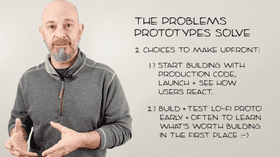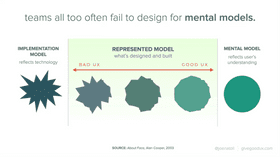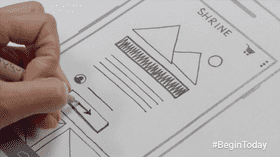
THE POWER OF LO-FI PROTOTYPING
Improving communication, collaboration + design.
Teams — and stakeholders in particular — are always tempted to skip prototyping and dive right into production-level code.
But in doing so, they're missing out on something. And that something isn't necessarily what you think.
Sure, lo-fi prototyping makes the end result a lot more useful to both users and the business — but what most people don't realize is that when done properly, it also does a tremendous amount of heavy lifting in improving team communication and collaboration.
It's a process that holds the power to prevent product design from becoming a ping-pong game of guesswork: a vicious cycle where the team is guessing at what the stakeholder wants, while the stakeholder becomes increasingly frustrated that what they’re seeing is not it. Design and development are at each other’s throats because the other side keeps surprising them with the latest round of iteration.
Prototypes are the perfect vehicle for increasing communication and collaboration.
They can, do and should generate product requirements. Leveraging that power ensures that when something unexpected comes up later (and it will), everyone involved in the project is in a position to anticipate and react to it quickly. Which keeps them from painting themselves into any number of corners.
I’ve seen the practices I’ve shared with you here adopted successfully by enterprise organizations of all shapes and sizes across multiple industries — from small startups to massive global companies, names you’d recognize. Those organizations put these principles into practice for one single, solitary reason:
They work.
I'd like to show them how to make them work for you as well, from the ground up.
14 Lessons
Already Joined? Login
1.0 Lo-Fi Prototyping Basics

1.1 What's a Prototype? (and what isn't?)

1.2 Problems Prototypes Solve

1.3 How Lo-Fi can predict and prevent failure

1.4 The many benefits of early Lo-Fi Prototyping
2.0 The WHAT: Formats + Rules

2.1 Format Overview and Rules for Lo-Fi

2.2 Characteristics of Lo Fi Prototypes

2.3 PROs of Lo-Fi Prototyping

2.4 CONs of Lo-Fi Prototyping
3.0 The HOW

3.1 The prototyping lifecycle

3.2 Paper or whiteboard prototyping

3.3 Lo-fi monochromatic wireframes

3.4 What When and How: The prototyping process

3.5 Tools of the trade: lo-fi prototyping software
4.0 Wrap Up: putting Lo-Fi to work for YOU
